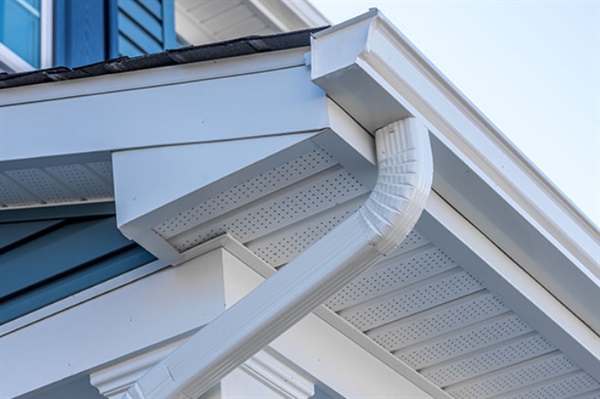Common Causes of Gutter Damage & How to Prevent Them

Gutters play a crucial role in safeguarding your home from water damage by directing rainwater away from critical areas like the foundation, walls, and roof.
Despite their importance, gutters often face damage due to various factors, leading to costly repairs and potential structural issues. Understanding these common causes can help homeowners maintain their gutters effectively and avoid unexpected problems.
In this article, we’ll explore the most common causes of gutter damage and answer key questions. These insights will help you make informed decisions about your gutter system and ensure its long-term performance.
Can Clogged Gutters Damage a Home’s Foundation?
Clogged gutters can lead to water overflow, which often results in water pooling around your home’s foundation.
Over time, this excessive moisture can cause soil erosion, weakening the foundation and leading to structural issues like cracks or uneven settling. Such damage is particularly problematic in areas with heavy rainfall or poor drainage systems.
Clogged gutters can cause basement flooding, which can damage the foundation. When water infiltrates through cracks or unsealed areas, it compromises the structural integrity of your home and creates conditions ideal for mold and mildew growth. Addressing clogs promptly can save significant repair costs in the long run.
It is crucial to ensure that your gutters are free of debris and functioning properly. Installing gutter guards and scheduling regular cleaning effectively prevent clogs and protect your home’s foundation from water-related damage.
What Materials Are Best for Durable Gutters?
The durability of a gutter system depends heavily on the material used. Aluminum is popular due to its lightweight nature, rust resistance, and affordability. It’s an excellent option for most climates and requires minimal maintenance. However, it can dent under heavy impact.
Steel gutters offer greater strength and durability, making them suitable for areas with extreme weather conditions, such as hailstorms. Stainless steel, in particular, provides excellent corrosion resistance but is more expensive than other options.
Copper gutters, while the most aesthetically pleasing and long-lasting, also come at a premium price.
Vinyl is an economical and lightweight option but may not withstand extreme weather conditions as well as metal alternatives.
Consider the climate and your budget when selecting gutter materials for the best results. Consulting with professionals like Pudas Construction can provide additional insights into the most suitable options for your home.
How Do Seamless Gutters Compare to Traditional Options?
As the name suggests, seamless gutters are constructed from a single piece of material and have no joints along their length, reducing the risk of leaks. On the other hand, traditional sectional gutters consist of multiple pieces joined together, which can weaken over time and develop leaks at the seams.
One of the main advantages of seamless gutters is their custom fit. Since they are tailored to the dimensions of your home, they provide better performance and a cleaner appearance. Their lack of seams also minimizes debris buildup, reducing maintenance needs.
However, seamless gutters typically cost more and require professional installation. Weighing the long-term benefits against the initial investment can help you determine which option best suits your home’s needs.
Warning Signs That Your Gutters Need Repair
Recognizing the signs of gutter damage early can prevent more severe issues. Common warning signs include sagging or pulling away from the roofline, visible cracks or holes, and peeling paint or rust spots. These issues indicate that the gutter system is no longer effectively channeling water away from your home.
Water stains on your home’s siding, persistent water pooling near the foundation, or basement flooding are additional signs of malfunctioning gutters. Regularly inspecting your gutters can help you spot these issues before they escalate into costly repairs.
Addressing these signs promptly by repairing or replacing damaged sections ensures your gutter system continues to protect your home efficiently.
Maintenance Requirements for Gutters in Cold Climates
In cold climates, gutters face unique challenges, such as ice dams. These occur when snow melts and refreezes at the roof’s edge, blocking water flow. The dams can cause water to back up under the shingles, leading to roof damage and leaks.
To prevent ice dams, ensure your attic is well-insulated and ventilated to minimize heat escape. Additionally, installing heat cables along the roofline and gutters can help melt ice and maintain proper water flow.
Regularly cleaning gutters during fall to remove leaves and debris also reduces the risk of ice formation.
Cold weather maintenance should also include checking for cracks and securely fastening the gutters. Investing in high-quality, weather-resistant materials further enhances durability in harsh winter conditions.
Contact Pudas Construction for Gutter Replacement
Properly maintaining your gutters is essential to protecting your home from costly water damage and ensuring its longevity. Whether you have clogged gutters, choose durable materials, or navigate maintenance challenges in cold climates, addressing these issues promptly can save you time and money.
If you need expert advice or professional assistance, Pudas Construction is here to help. Contact us today at 612-481-3053 or visit our Get a Free Estimate page to schedule your consultation and protect your home year-round.